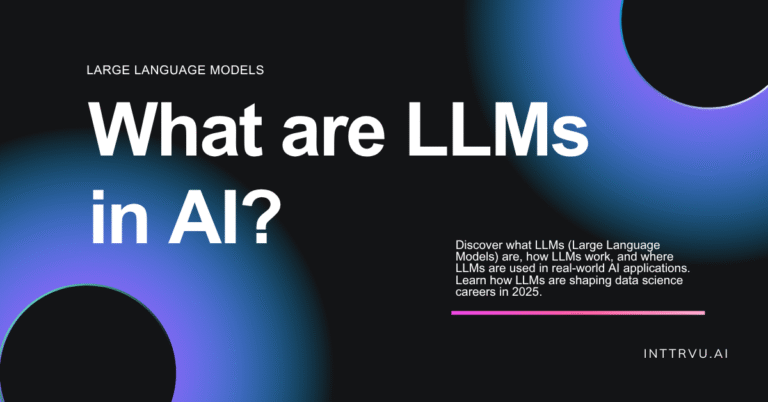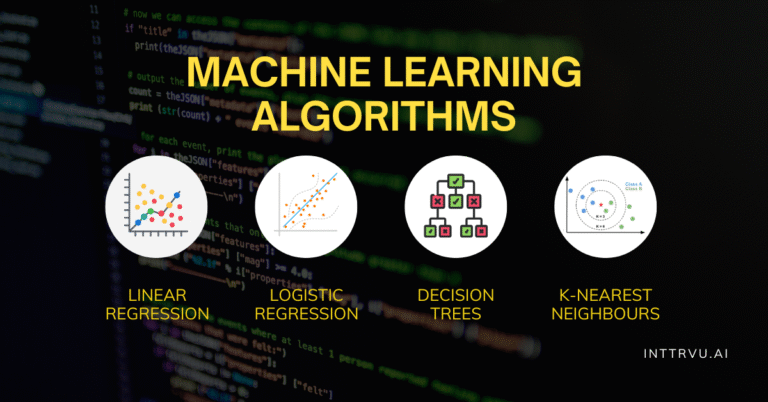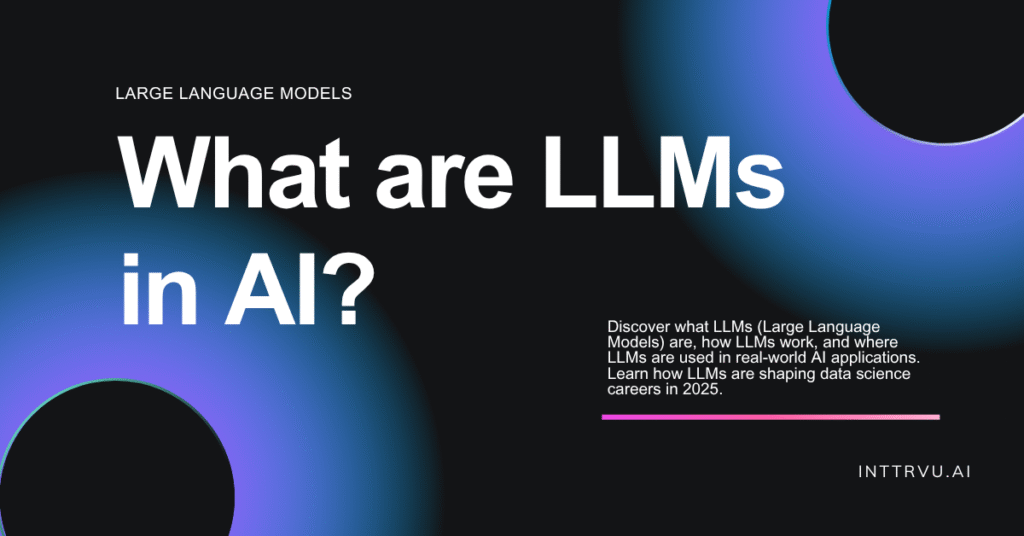What are LLMs in AI? Understanding Large Language Models & Their Impact
Introduction
Imagine an AI that can write essays, answer your toughest questions, generate code, and even mimic human conversation. It may sound like science fiction, but it’s not. It’s the reality of Large Language Models (LLMs), one of the most groundbreaking advancements in modern artificial intelligence.
Whether you’re a working professional looking to transition into a data role or a student exploring the future of AI, understanding LLMs is no longer optional; it’s essential. LLMs are reshaping industries, transforming how we interact with machines, and unlocking new career opportunities in data science, engineering, and analytics.
What is a Large Language Model (LLM)?
A Large Language Model (LLM) is a category of artificial intelligence models that has revolutionized how machines understand and generate human language. Unlike traditional NLP models, which were designed for specific tasks, LLMs are general-purpose language models trained on extremely large text datasets,often including billions or even trillions of words. This enables them to handle a wide variety of tasks without being explicitly programmed for each one.
At their core, LLMs function by predicting the next word in a sentence, which might sound simple,but the scale and architecture behind this task allow LLMs to write stories, summarize research papers, write complex code, answer customer service queries, and even reason with some degree of logic.
Most LLMs, such as OpenAI’s GPT, Anthropic’s Claude, or Meta’s LLaMA, are built using Transformer architecture, which gives them the ability to handle long-range dependencies in language, understanding not just individual words but the context of an entire paragraph or conversation.
Today, LLMs are the foundation of modern AI applications, from chatbots to coding assistants, and their flexibility makes them one of the most sought-after technologies across industries.
If you’re looking to build a career in Data Science, AI, or NLP, gaining a solid understanding of LLMs is crucial. At INTTRVU.AI, our Data Science Certification and Interview Preparation Programs are designed to help professionals and aspiring learners get hands-on with concepts like LLMs, while also preparing you for real-world roles in the evolving AI landscape.
How Do LLMs Work?
While LLMs may appear like magic from the outside, they rely on sophisticated mathematical models, architecture, and training processes. Here’s a step-by-step breakdown:
1. Data Collection and Preprocessing
To create a robust Large Language Model, vast and diverse data sources are used,such as books, academic articles, Wikipedia, social media, codebases, and public websites.
This data is then tokenized, meaning it is broken down into smaller parts like words, sub-words, or characters. These tokens become the input units that the model learns from.
2. Training Using Transformer Architecture
The heart of every modern LLM is the Transformer, a neural network architecture introduced by Google in 2017. It uses mechanisms like self-attention to understand the relationship between different words, even when they are far apart in the sentence.
Example: In the sentence “The girl who was wearing a red dress smiled,” the model understands that “girl” is the one “smiling”, even though several words are in between.
During training, the LLM repeatedly tries to predict the next token in a sequence. Over billions of iterations, the model becomes increasingly proficient at understanding grammar, meaning, and context.
3. Fine-Tuning and Prompt Engineering
After the base LLM is trained, it can be fine-tuned on specific tasks,like medical question answering or legal document summarization. Additionally, users can guide LLM outputs through prompt engineering, where carefully phrased input prompts generate targeted responses.
4. Inference and Real-Time Deployment
Once trained and deployed, LLMs respond to real-time user inputs. These outputs are generated through a probabilistic ranking of words, which balances creativity and accuracy depending on the use case (chat, summarization, coding, etc.).
Challenges and Limitations of LLMs
Despite their groundbreaking capabilities, Large Language Models (LLMs) come with several technical and ethical challenges that organizations and AI practitioners must consider:
1. Bias and Fairness
Because LLMs are trained on internet-scale data, they often inherit the biases and stereotypes present in their training corpora. This can result in:
- Offensive or politically biased outputs
- Stereotypical gender or ethnic assumptions
- Inequitable treatment in sensitive domains like hiring or law
Efforts like RLHF (Reinforcement Learning with Human Feedback) help reduce these issues, but they are not foolproof.
2. Hallucination and Factual Errors
One of the most cited limitations of LLMs is hallucination, when the model generates information that is syntactically correct but factually incorrect. This is particularly risky in fields like healthcare or legal analysis, where accuracy is non-negotiable.
3. Compute and Environmental Costs
Training a large LLM like GPT-4 requires massive computational infrastructure, including high-performance GPUs, TPUs, and huge datasets. This translates to:
- High energy consumption
- Environmental concerns
- Expensive infrastructure for smaller organizations
4. Data Privacy and Security Risks
Since LLMs often scrape public data, there’s a risk of:
- Unintended data leakage (e.g., including private information in responses)
- Adversarial attacks where malicious inputs cause harmful outputs
Regulatory non-compliance under GDPR, HIPAA, or other laws
5. Lack of Reasoning and Understanding
Despite their fluency, LLMs do not “understand” the world. They lack common-sense reasoning, real-world grounding, and emotional intelligence. They’re excellent predictors,not thinkers.
Applications for LLMs in Real-World AI Use Cases
LLMs are not just research tools; they are commercially deployed AI systems that are driving innovation across almost every major industry. Thanks to their generalist capabilities and natural language processing skills, LLMs are redefining how organizations handle automation, customer experience, content generation, and more.
1. Natural Language Processing (NLP) Tasks
Traditional NLP tools were narrow in focus, but LLMs can perform multiple NLP tasks without fine-tuning:
- Text Summarization: Automatically condensing long documents into short summaries.
- Sentiment Analysis: Determining whether text reflects positive, negative, or neutral sentiment.
- Named Entity Recognition: Identifying people, places, companies, and other named entities.
- Question Answering: Providing context-aware answers to open-ended or factual queries.
2. Conversational AI and Chatbots
LLMs are at the heart of today’s most advanced chatbots and virtual assistants, enabling:
- Human-like dialogue generation
- Multi-turn conversations with memory of prior context
- Support in multiple languages
- 24/7 customer interaction with reduced human workload
This is especially useful in sectors like e-commerce, finance, travel, and education.
3. Code Generation and Debugging
LLMs like OpenAI Codex and GitHub Copilot are transforming software development:
- Auto-generating code from plain English prompts
- Suggesting optimizations
- Identifying bugs or refactoring existing code
This speeds up development and reduces cognitive load for engineers.
4. Healthcare and Legal Document Analysis
In domains like medicine and law, where professionals deal with massive documentation:
- LLMs help summarize medical journals, generate discharge reports, or translate documents.
- They also assist legal professionals in contract analysis, due diligence, and legal research.
5. Content Creation and Marketing Automation
Marketers now use LLMs to:
- Generate SEO-optimized blogs
- Create email templates
- Draft ad copies and product descriptions
- Personalize messages at scale
LLMs have made high-quality content generation more accessible and scalable than ever before.
Summary Table: Key Insights on LLMs (Large Language Models)
| Aspect | Details |
|---|---|
| Definition of LLMs | LLMs (Large Language Models) are advanced AI systems trained on massive text data to understand and generate human-like language. |
| How LLMs Work | LLMs use transformer architecture and deep learning to predict the next word in a sequence, enabling natural language understanding and generation. |
| Applications of LLMs | Common uses of LLMs include chatbots, content creation, code generation, customer support, legal document review, and research summarization. |
| Benefits of LLMs | LLMs offer scalability, automation, multilingual support, and human-like interaction, helping businesses save time and improve productivity. |
| Challenges of LLMs | LLMs face issues like data bias, hallucination (factual errors), high computational cost, and limited real-world understanding. |
| Career Relevance | Professionals skilled in using or integrating LLMs into business or tech workflows are in high demand in data science and AI careers. |
Frequently Asked Questions
LLM stands for Large Language Model, a deep learning model trained on text data to understand and generate human language. It's used in chatbots, virtual assistants, content creation, and more.
LLMs predict the next word in a sequence and generate human-like responses, summaries, code, or even translations depending on the task.
Absolutely. LLMs are revolutionizing AI applications, and understanding how they work will give you a significant edge in interviews, model building, and AI-driven problem-solving.
us nec ullamcorper mattis, pulvinar dapibus leo.

What are LLMs in AI?
Discover what LLMs (Large Language Models) are, how LLMs work, and where LLMs are used in real-world AI applications. Learn how LLMs are shaping data science careers in 2025.

Machine Learning Algorithms
Master the top machine learning algorithms every data scientist must know in 2025. Learn definitions, real-world examples, complexities, and how to apply them effectively. Includes expert guidance from INTTRVU’s AI certification and interview preparation program



